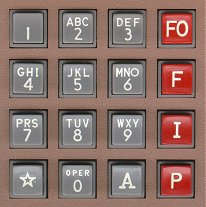With awfully huge changeset https://github.com/tomek-o/tSIP/commit/284ba31d9de450fbaa2f8161ad11c1ecc563d338 I've made most of the dialpad (excluding volume trackbars and transfer edit, but this should be separate change) configurable. Button container covers whole dialpad area, each of the 215 buttons can be assigned (parentId) to either dialpad or "main" container. There is automatic settings conversion from versions 0.1.x and 0.2.0.x.
Compiled exe is at http://tomeko.net/tmp/tSIP.exe. It is not thoroughly tested yet and may be subject of further changes, so if you have put work into your current configuration, backup it first.
Example settings for two-line button is attached below. Using bitmaps might be another option.

 Side note: if you would have number in clipboard (though this is I suppose less likely than having number on flyer or something like that) then using script to change letters to digits would be more convenient than using keypad.
Side note: if you would have number in clipboard (though this is I suppose less likely than having number on flyer or something like that) then using script to change letters to digits would be more convenient than using keypad.


 Working: 16 DTMF buttons + CALL + HANGUP. In this type of kiosk-like application most functionality would be probably provided by scripts. For practical reasons functionality like registration (if used) state indication and call state indication would be valuable - there are script events for this and several button properties can be changed/updated from scripts.
After pressing "3" four times and then "CALL" it should call sip:3333@sip2sip.info test number/URI. This is defined by "on_btn_call.lua" script assigned to "CALL" button. Button bitmaps for normal and pressed states are specified in static configuration and inside on_button_mouse_up_down.lua script.
Working: 16 DTMF buttons + CALL + HANGUP. In this type of kiosk-like application most functionality would be probably provided by scripts. For practical reasons functionality like registration (if used) state indication and call state indication would be valuable - there are script events for this and several button properties can be changed/updated from scripts.
After pressing "3" four times and then "CALL" it should call sip:3333@sip2sip.info test number/URI. This is defined by "on_btn_call.lua" script assigned to "CALL" button. Button bitmaps for normal and pressed states are specified in static configuration and inside on_button_mouse_up_down.lua script.
It seems the number buttons cannot be modified. Any way to make them show the letters, e.g. 2 = ABC, 7 = PRS... 0 = OPER? MicroSIP has letters on the buttons. I can't seem to be able to add these using Caption 2 either, there are no modification options. This makes dialing using letters difficult.
Originally posted by @InterLinked1 in https://github.com/tomek-o/tSIP/issues/10#issuecomment-808792854